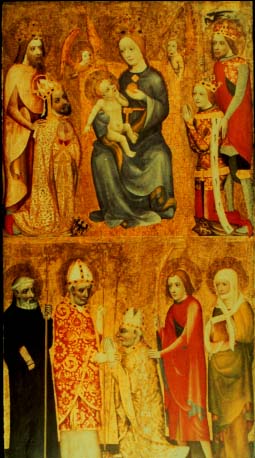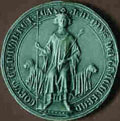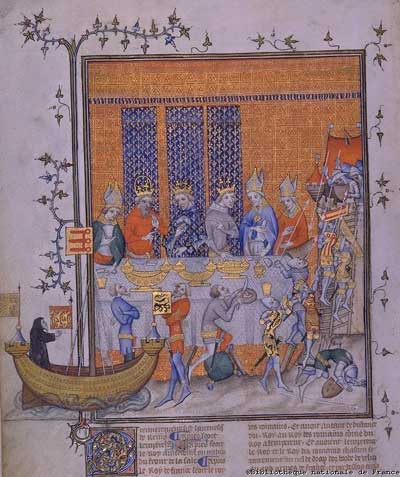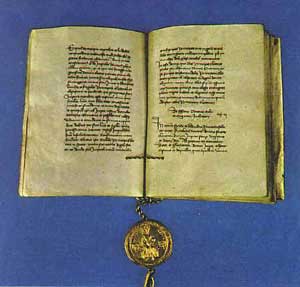The Luxembourg Dynasty and King Charles IV

|
With the demise of Wenceslas III, the last of the Premysls rulers of the Czech lands, the difficult question of who should rule next had to be answered. And answered it was - by 14-year-old John of Luxembourg, the first of the Luxembourgs to occupy the Czech throne (1310-1437). John of Luxembourg gained this position with the support of the Czech nobility by marrying 18-year-old Eliska Przemyslova, the sister of the late Wenceslas III. Under John of Luxembourg's rule, more territories - including the regions of Cheb, Lusatia and Silesia - were joined to Bohemia. All of these regions together, under the rule of John of Luxembourg, came to be known as the "Lands of the Czech Crown." So you see, there never was an easy "one-word" way (like 'Czechia') to describe this part of the world, not even in way back in the 14th century. John of Luxembourg was a good king, but he had a fatal weakness for chivalry, knighthood, honour - and especially, for battles. He loved to fight. When there weren't any battles in his immediate neighborhood, he went abroad to help his friends fight their battles. And so it happened that he fell at the battle of Crecy in 1346, fighting on the side of his French friend and distant relative Charles, against the Black Prince. And so he was succeeded by his young son, Charles IV. 
Charles IV was just as noble - but much more practical than his caravanting father had been, and he took a keen interest in all aspects of rule over the Czech lands. Charles IV was not really named Charles. He was named Wenceslas IV - but he had been reared at the French court, and everyone there called him Charles, and so the name stuck. (His son, who succeeded him on the Czech throne, was also named Wenceslas IV, and this sometimes leads to some confusion.) When Charles IV came to power, he was still very young. Since he'd been raised in France, he didn't speak Czech. Wicked advisors surrounded the young king, and attempted to usurp the real rule of Bohemia while leaving young Charles IV in place as a figurehead. Charles IV may have been young, but he was no dummy. He spoke 5 languages fluently (at a time when many crowned heads could not even read and write), and he was a masterful diplomat. He also had friends in high places - Pope Klement, who was elected during Charles IV's reign, had been the Czech sovereign's tutor at the court in Paris. Young Charles IV saw through the transparent plans of the wicked advisors who surrounded him. He quickly learned Czech, and took over rule of his own land himself. Charles IV was very clever, very devout, and very savvy. He was also a lover of art and a collector of holy relics (which he kept under lock and key all year long except for Easter, when he paraded them through the country like a travelling circus). 
Charles V's banquet, at the royal palace, in honor of Emperor Charles IV ( Wenceslaus IV ); with entertainment commemorating the First Crusade and the capture of Jerusalem by Godfrey of Bouillon The medieval Czech state reached the zenith of its power and importance Charles IV. He was the King of Bohemia, later also Holy Roman Emperor, and today he is known as the Father of the Czech Nation. Charles was a very good king, and he paid attention to detail. It was he who made sure that the status of the "Lands of the Czech Crown" - the territories his father had gathered together under his rule - was legally fixed (this task was made all the easier since he was Holy Roman Emperor). He initiated a number of building projects in his reign, especially in Prague. It was at his behest that Charles Bridge and St. Vitus' Cathedral were built, and the "Hunger Wall" that he commissioned (remnants of which still stand today on Petrin Hill in Prague) is thought to be the first works-project in the world, as he had it built to create employment for the poor and hungry masses (hence the name). Charles IV personally planned Prague's "New Town" district, where Charles Square - which is also named for him - lies. Karlstejn Castle and Karlovy Vary (Carlsbad) are also named for Charles IV. Many of the building projects initiated by Charles IV still stand, and most are perfect examples of the Gothic style of architecture, which is characterized by clean simple lines and solid structure - like the Charles Bridge and its towers, the Carolinum, or the Old-New Synagogue. 
The "Golden Bull," Imperial Basic Law of Charles IV. Dated 1356, it affirms Frankfurt's status to forever be the city of election and coronation of German Emperors Charles IV also founded Charles University, the first center of higher education in all of Central Europe. During his reign, Prague was the capital of the Holy Roman Empire (a gilded sign on the Old Town Hall still proclaims "Praga Caput Regni" today), and he successfully lobbied to have the Prague bishopric made an archbishopric (this task was actually quite easy, as the privelege was granted him by his former tutor, now the Pope.) It was Charles IV, too, who brought the cultivation of the grape and the wine industry to the beer-drinking Czech lands. That isn't to say that he neglected the beer industry - under his reign, stiff prison sentences were meted out to those caught exporting cuttings of prize Czech hops - essential to the brewing of great Czech beer - abroad. Charles IV had no fewer than four wives, and any number of progeny, both legitimate and il. Of these, his oldest legitimate son, Vaclav IV, was naturally chosen as his successor. 
|
Charles University
Charles Bridge
Other famous people & artists
Back